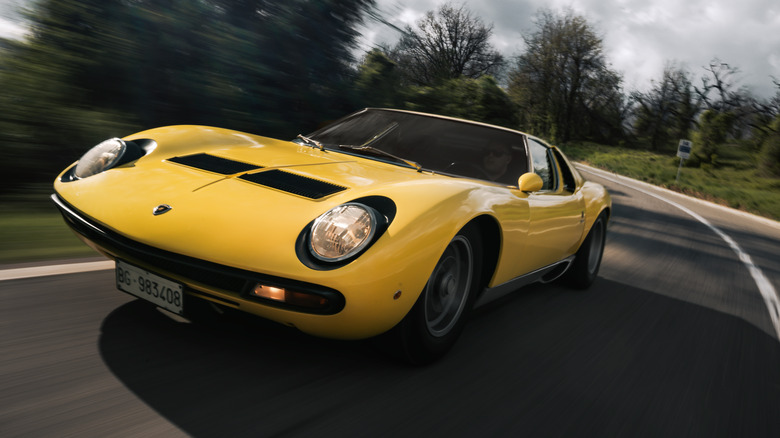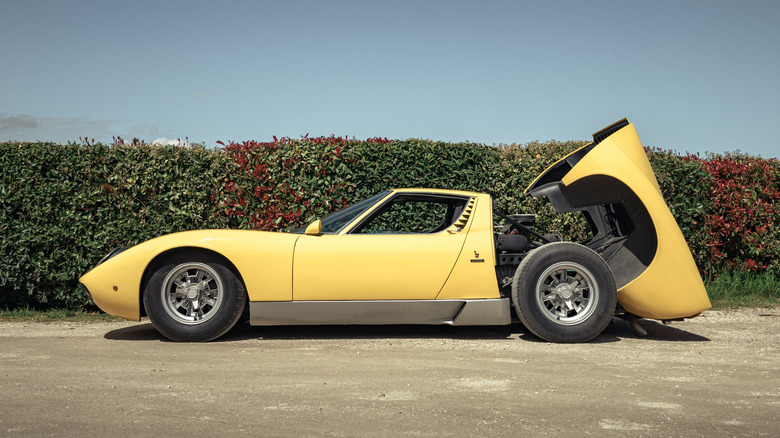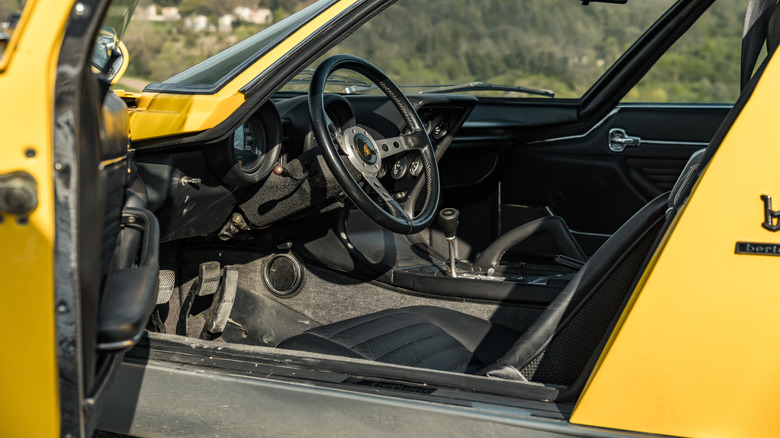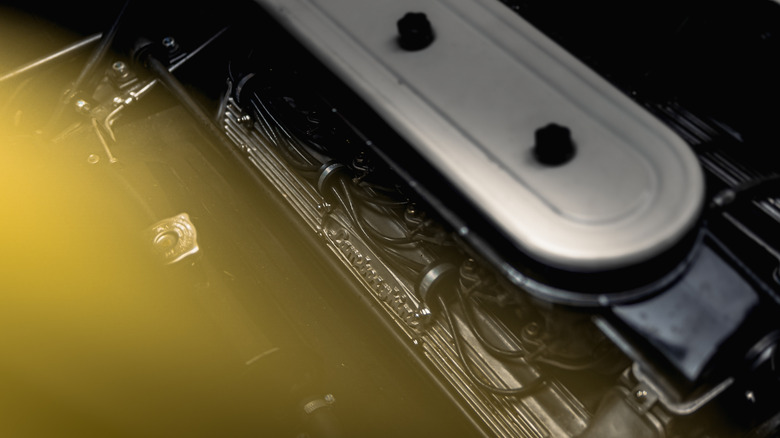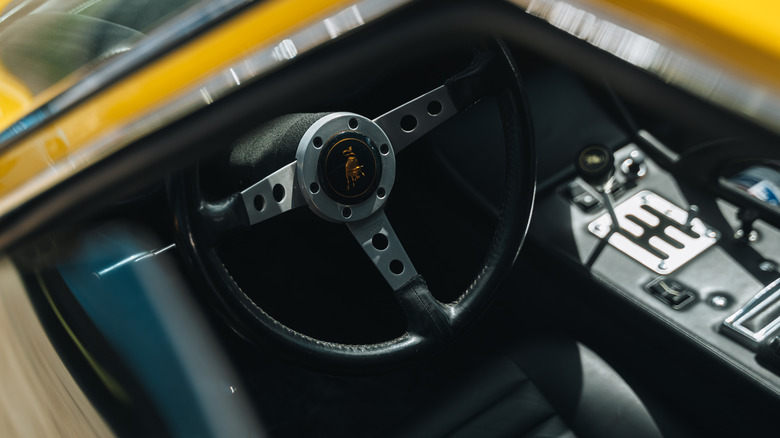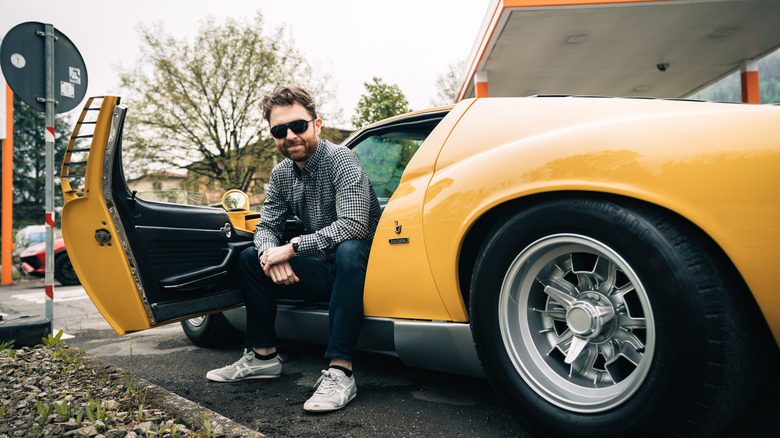Driving The Lamborghini Miura: History's First & Greatest Supercar
There's a reluctance to the firing of the 3.9-liter V12 that sits at the heart of the Lamborghini Miura, mounted cross-wise just behind and beneath where I'm wedged in the cockpit. The starter seems to be struggling to spin all twelve pistons. That's a lot of moving parts, after all, and none of them seem inclined to wake.
I don't blame the thing. It's a drizzly April morning, cloudy skies above and damp roads below. Hardly ideal conditions for my first go in a searing yellow supercar.
Outside of the car, a generously sized man in a Lamborghini shirt wags his right hand in the air, emulating a foot pressing on a throttle. So, I oblige. A little gas, a twist of the key, and again nothing but a sullen groan from the starter. And then boom. The engine fires, comes to life, spins up on its own accord with a kind of irritated intensity. I have successfully woken this bull from its slumber and it doesn't seem happy about it.
I, though, couldn't be more excited.
A tractor company turned supercar star
This is a Lamborghini Miura, the car that in the mid-'60s changed Lamborghini from a curiosity — an Italian tractor company that also made a lovely grand tourer — into a global supercar powerhouse. In fact, this is the car that originated that term.
We've been debating the category ever since, trying to determine which cars deserve that honorific, and — in an era when pick-up trucks can sprint to 60 in 3.5 seconds – it's not getting any easier. But there can be absolutely no doubt: the Miura is supercar incarnate.
Lamborghini made fewer than 800 Miuras in a variety of flavors, starting with the P400. P stands for "posteriore" — Italian for rear, a reference to this being Lamborghini's first car with the engine at the back. (It is a bit of a misnomer as the engine's in the middle, but let's not fret the semantics.) The 400 refers to the displacement of the engine, a V12 that previously saw duty in the nose of the company's 400 GT and Isolero.
Later came the racier 400S, then a roofless Roadster version, then a one-off, race-ready version called the Jota, before the final version you see here, the SV, or Super Veloce. Yeah, you don't have to break out Google Translate to figure that one out: super fast.
How fast? Top speed on the Miura SV is 174 mph, pretty stout in a car with 50-year-old brake and suspension technology. The SV had more power, better handling, and wider tires than the base Miura. The fenders on the car were flared to accommodate and, to match the car's racier persona, the Miura's classic eyelashes around the headlights were snipped. The result is the rather more aggressive stance and stare of the SV you see here.
Only four SVs were made, primo provenance enough, but this one is the last assembled, rolled especially off of the Museo Lamborghini show floor and into my eager hands for the drive of a lifetime.
Peeking inside the Miura's interior
It was a chilly, rainy morning outside Sant'Agata Italy when I got my go in the Miura SV, a car that Lamborghini's personnel estimated is worth somewhere north of $2.5 million.
The Miura is Lamborghini's last V12 with doors that open horizontally. Though the hinges may be traditional, the shape of the doors is not, arcing up dramatically at the rear in a shape that, per styling house Bertone, is meant to evoke the horns of a bull. So we have eyelashes up front, horns in the middle, and yes there's a tail at the rear, a little cheeky one that hangs off the side of the Miura logo.
Bucket seats are low and flat with little in the way of lumbar support. You feel like you're sitting on the ground and, given how low the Miura is, you're certainly not far off.
The wide steering wheel sits in front of a pair of widely spaced Jaeger gauges, 320 km/h speedo on the left, 10,000 RPM tachometer on the right. Interestingly, no redline is marked. The invitation is clear. Six more gauges are stacked to the right, but otherwise there's hardly any dash. Controls for lights and heater are mounted on the roof. Your view ahead is delightfully free.
A five-speed gated shifter sits at a jaunty angle, bending up and back in an obliging way, knob bearing a few small cut-outs for your fingers that give a hint at the level of commitment shifting this thing will require.
The heart of the Miura
It's the pedals that demand the most getting used to, however. Though the size of the pedal box is infinitely wider than the Miura's successor, the Countach, the problem here is height. It feels all the world like Lamborghini tucked the pedals under the dashboard. During the drive my toes constantly got caught up in there, which is not an encouraging thing on a worryingly expensive, notoriously finicky car.
Though I'd successfully started the Miura with a healthy application of throttle, it still wasn't fully woken up. It refused to idle, falling dead at every stop sign and traffic light. So, I quickly learned to cover the throttle and brake with my right foot, giving a jab at the gas every 10 seconds or so, revving the engine like a would-be street racer desperate for attention.
As good as that V12 sounds stationary, it's an otherworldly noise when opened up on the open road. I made copious notes after the drive describing the sonorous divinity of that engine and the short, straight pipes that it sings through, but since those notes are full of expletives I'll simply say that it is a very, very good sound.
And the handling? I'll be honest in saying that the narrow, crumbling roads around Bologna are not ideal for pushing a museum car worth more than my life. The constant traffic didn't help, especially when much of it was hurtling in the opposite direction on a road barely wider than the Miura itself.
A gated shifter and cross-drilled wheel
It took me a long while to get comfortable. Literally. With my legs splayed to either side of that wheel, just figuring out how to effectively steer the thing took some time.
But that steering is surprisingly light, somewhat slow but with delightful feedback. The shifter, on the other hand, requires a firm hand and precise movements. This isn't a modern transmission with a cute, decorative gate applied. Finding gears within this metal framework requires precise, authoritative movements. You can't ease your way diagonally from two to three like you can on a modern transmission. It's three distinct movements: up, right, up. Try to take a short-cut and you'll instead get a disapproving clunk as the shifter smacks into that gate.
Double-clutching up and down helps things go more smoothly, more so if you can manage to rev-match without fumbling your feet on the pedals.
After about 30 minutes my feet started to find their way and everything else began to fall into place. The traffic disappeared, the sun came out, the roads dried, and I really started to enjoy things. Getting the cadence of the gearbox down, double-clutching without trapping my toes under the dash, I could push this car just hard enough to get it to start moving through the corners.
But the Miura doesn't move only on the corners. Even on a straightaway the car is dancing and bouncing and feeling nervous. Some combination of short wheelbase, crude suspension, and complete lack of driver aids give the Miura a liveliness that modern supercars lack. Driving slow in this thing feels fast, something you can't say about an Aventador.
Always style
But then supercars were always about speed and style more so than experience, and so that's not a knock against modern Lamborghinis, which are not only far faster and far more capable but far more manageable, too. At the end of the day I tottled home in the latest, most advanced Lamborghini on sale today, the Huracan Tecnica, 640 horsepower and a top speed of 202 mph — almost 30 higher than the Miura.
It's a wicked track beast with steering sharp as a razor but, in Strada mode, it was as comfortable as a Camry, slipping gently between gears and keeping me at the perfect temperature even as the evening settled in.
It's easy to desire a car that's always on, as the Miura most certainly is, but you have to respect one that can dice it up with the best on the track and then usher you home in comfort and style.
Always style.
